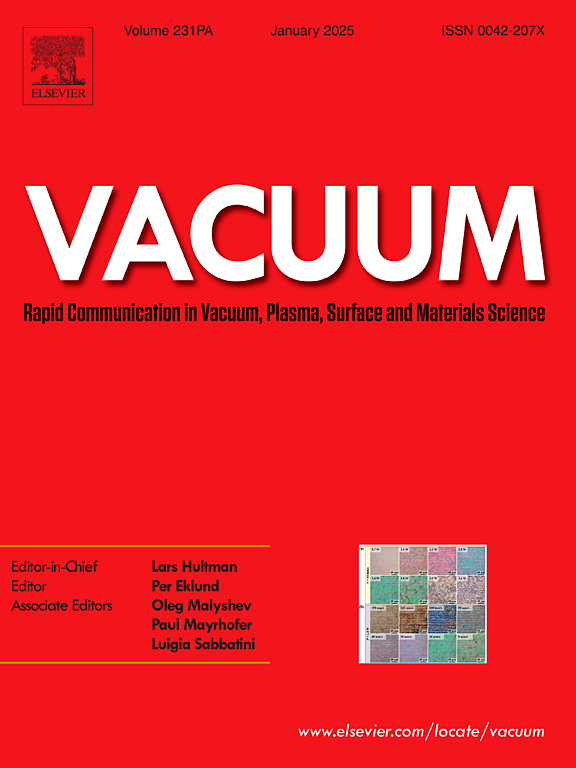碳、氢共掺杂AlN薄膜晶格结构随温度的演化机理
IF 3.8
2区 材料科学
Q2 MATERIALS SCIENCE, MULTIDISCIPLINARY
引用次数: 0
摘要
在不同N2/CH4气体流量比下,在石英玻璃上沉积了碳、氢共掺杂AlN薄膜(AlN&C-H)。研究了N2/CH4比对AlN&;C-H样品晶格结构的影响。AlN&;C-H样品的x射线衍射峰明显左移,说明C和H共掺杂导致AlN薄膜晶格膨胀。XPS结果显示了Al晶格上的间隙C-H和取代C-H。高分辨率TEM图像显示碳和氢共掺杂导致了质量位错。采用高温退火方法修复了AlN&;C-H样品的缺陷。阐明了AlN&;C-H样品的晶格结构随温度的演化规律。用x射线衍射角(2θ)表示晶格结构的修复程度。在700 ~ 1100℃的温度范围内,2θ值随温度线性增加。2θ随温度的线性变化关系可作为测温的判据。本文章由计算机程序翻译,如有差异,请以英文原文为准。
Lattice structure evolution mechanism of carbon and hydrogen co-doped AlN thin films with temperature
Carbon and hydrogen co-doped AlN thin films (AlN&C-H) are deposited on quartz glass with different N2/CH4 gas flow ratios. The influence of N2/CH4 ratio on the lattice structure of AlN&C-H samples is studied. X-ray diffraction peak of AlN&C-H samples shifts to the left obviously, which illustrates that C and H co-doping lead to lattice expansion of AlN thin films. XPS results indicate the interstitial C-H and the substitutional C-H on the lattice sites of Al. High-resolution TEM images exhibit that carbon and hydrogen co-doping causes mass dislocations. High-temperature annealing is used to repair the defects of AlN&C-H samples. The lattice structure evolution law of AlN&C-H samples with temperature is clarified. X-ray diffraction angle (2θ) is carried out to indicate the lattice structure repair degree. In the temperature range of 700∼1100 °C, the 2θ value increases linearly with temperature. The linear variation relation of 2θ with temperature can be used as a criterion for temperature measurement.
求助全文
通过发布文献求助,成功后即可免费获取论文全文。
去求助
来源期刊

Vacuum
工程技术-材料科学:综合
CiteScore
6.80
自引率
17.50%
发文量
0
审稿时长
34 days
期刊介绍:
Vacuum is an international rapid publications journal with a focus on short communication. All papers are peer-reviewed, with the review process for short communication geared towards very fast turnaround times. The journal also published full research papers, thematic issues and selected papers from leading conferences.
A report in Vacuum should represent a major advance in an area that involves a controlled environment at pressures of one atmosphere or below.
The scope of the journal includes:
1. Vacuum; original developments in vacuum pumping and instrumentation, vacuum measurement, vacuum gas dynamics, gas-surface interactions, surface treatment for UHV applications and low outgassing, vacuum melting, sintering, and vacuum metrology. Technology and solutions for large-scale facilities (e.g., particle accelerators and fusion devices). New instrumentation ( e.g., detectors and electron microscopes).
2. Plasma science; advances in PVD, CVD, plasma-assisted CVD, ion sources, deposition processes and analysis.
3. Surface science; surface engineering, surface chemistry, surface analysis, crystal growth, ion-surface interactions and etching, nanometer-scale processing, surface modification.
4. Materials science; novel functional or structural materials. Metals, ceramics, and polymers. Experiments, simulations, and modelling for understanding structure-property relationships. Thin films and coatings. Nanostructures and ion implantation.
 求助内容:
求助内容: 应助结果提醒方式:
应助结果提醒方式:


